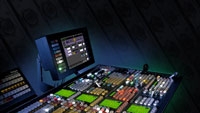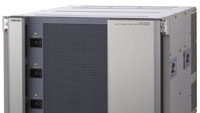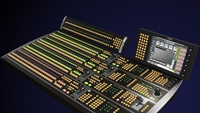Vendors throw 3Gb/s switch
With the emergence of 3-D and the desire for better-quality live replays, the need for more bandwidth for live sports production has cast a new light on the availability of large-scale production switchers capable of handling 1080p/60 signals. The format has been talked about for several years as the “holy grail” because it offers lots of space for all types of video data files, and, from it, all other HD formats can be extracted for parallel (3-D, HD and SD) distribution.

With last summer’s Olympic Games in Beijing, the value of such production was crystal clear in the numerous HD replays that were captured with 3x slow-motion cameras from Grass Valley and Sony. There were even higher frame rate cameras from I-Movix and Vision Research in the mix. What they all had in common was a need for an infrastructure that could process a 60fps signal at 3Gb/s. Current HD productions move data at half that rate (1.5) to produce sporting events — at 30fps — in both the 720p and 1080i formats.
To date, the only equipment readily available to handle such bandwidth-intensive productions were routers, signal-processing cards that go into routers, external processing units (like frame synchronizers and color correctors) and storage devices. That’s because customers have been slow to ask for anything larger. Those building new facilities have installed “3Gb/s-ready” routers as a way to future-proof themselves.
Looking around, there is some real interest in the format. ESPN has made it clear to the various vendors that it will not install any production gear that is not at least upgradeable to 3Gb/s capability and the Miami Heat professional basketball team has installed an HD production suite inside its new American Airlines Arena that includes the ability to output a 3Gb/s signal. In addition, system integrators say they are beginning to get more proposals for it.
Testing the waters at NAB
This year’s NAB Show will have the makers of large-input production switchers talking about the HD format. For some, like Grass Valley, Ross Video and Snell & Wilcox, it will mostly be just talk, because all have stated their reluctance to put too much emphasis on a format that has few takers. For other, smaller-sized companies, however — such as Broadcast Pix, Echolab and FOR-A — products will be on the floor for hands-on demonstrations.

Among current large-input switchers on the market, Grass Valley’s Kalypso series, Ross’ Vision QMD/X series, Sony’s MVS8000G series and Snell’s Kahuna series all have the ability today to handle these signals by using two M/E channels in place of one. However, some say this can cause signal degradation.
Thus, a four-M/E switcher becomes a two-M/E system, which limits the amount of sources that can be used. A 40-input production using 3Gb/s cameras and other sources will have 20 inputs available to it, because the switcher is processing twice as much data. The 3Gb/s source is converted to dual link on the input, processed as a 1.5Gb/s signal via the internal engine, then converted back to 3Gb/s on the output. In most cases, this configuration also requires a “minor” software tweak.
The professional video industry's #1 source for news, trends and product and tech information. Sign up below.
At NAB, Sony will demonstrate its MVS8000G, which currently offers the ability to handle 3Gb/s productions by using its internal 1.5 architecture in a dual-link configuration. The company will have the MVS8000G switching 3-D content from the NFL and NBA games that have been experimented with. These events also used Sony HDC-1500 HD cameras as well. Sony plans to announce single-link 3Gb/s capability at the show, but will not deliver until “possibly” later this year.
Chris Marchitelli, marketing manager for Sony’s Content Creation division, said it could be five years before 1080/60p signals are broadcast to the home (where many sets have now infiltrated the living room), but vendors have to invest in R&D now to get the product ready.
Seeking demand
“We don't see a big demand [for 3Gb/s processing] today, but as more new facilities are built, engineers are thinking about the 1080p/60 format and adding it into their future roadmaps,” he said.

With the major switcher vendors holding off on native 3Gb/s capability this year, there’s an opportunity for some of the smaller players to make some noise. That’s perhaps why companies like Broadcast Pix and Echolab have announced they’ll show (or soon will show) such products.
Broadcast Pix will show its new Slate G Series, replacing its current generation of live, integrated production systems, with a new quad workstation that houses the Slate video processing boards and is upgradeable to 3Gb/s 1080p boards (expected later this year). The Slate G Series and a prototype of its 3G upgrade will be shown at NAB in the Broadcast Pix booth (SU2617).
“There’s ongoing discussions that we’ve had with customers, who are considering investing in a new switcher but don't want to have to get rid of it in there years when 3Gb/s is commonplace,” said Ken Swanton, president of Broadcast Pix. “That’s why having a clear, upgradeable path is the right solution for smaller broadcasters and production facilities that have embraced our products.”
Making the overture
Echolab has developed a new platform for its Overture switchers unveiled at last year’s NAB Show that includes the internal circuitry necessary to perform single-link processing of 3Gb/s signals. Of course, the system didn’t have 3Gb/s I/O connectors then because the company couldn't readily get the necessary serializers. This year, the components are available, and they’re now available on the switcher.
“There’s still very little 3Gb/s equipment out there in users’ hands, so there’s not a lot of need for switching of these types of productions,” said Echolab President Nigel Sprattling, adding that he’s had trouble finding 3Gb/s sources to test the company’s Overture switcher. Echolab will demonstrate its Overture switcher routing sources from a Blu-ray player, for lack of a 1080p/60 camera.
“We built the Overture MD switcher for 3Gb/s from the start because we are new to the large switcher game and had to make a stand,” he said. “We had the capability last year but didn’t bother to talk about it because nobody would have been interested.”
Large input, 3Gb/s
FOR-A will showcase its HVS-5000 switcher series at NAB for the second straight year. The switcher — in three sizes — was one of the first prototype 3Gb/s models available, and the first large-input switcher for FOR-A. In addition to 1080/60p HD signals, the switcher supports 1080/59.94p and 1080/50p formats (for European broadcasters). An optional up/downconverter card also supports mixed input from HD and SD signals.
“The company wanted to be the first to make the move, recognizing that it will be part of our industry’s future,” said Anthony Klick, Northeast and Midwest sales manager for FOR-A. The company markets 3Gb/s color correctors and frame synchronizers as well. “We know that the American market is not 100 percent mature, but in other parts of the world [Europe, Korea and Latin America], we have sold 10 of these switchers.”
The investment in large-scale switchers is significant, both financially and logistically, considering that the buyer will probably use it for at least 10 years. In the end, it’s up to the customer to decide how soon the format will truly take off.
“I’m curious what the American market, particularly sports producers, is going to say this year,” Klick said. “Last year, we gave them a taste, and this year, they'll see production models on the floor. Now, it’s up them.”
